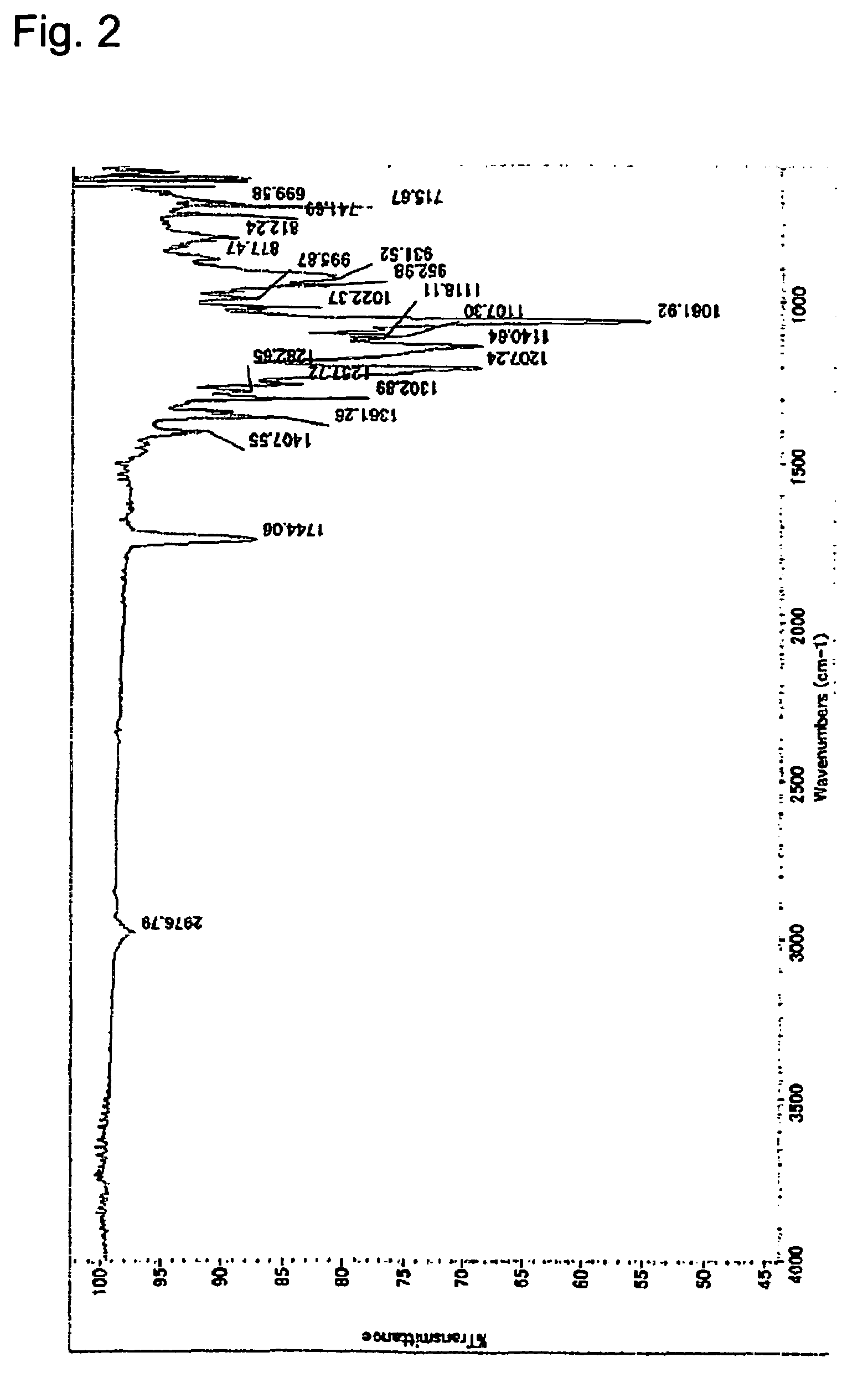Cyclic fluorine compounds, polymerizable fluoromonomers, fluoropolymers, and resist materials containing the fluoropolymers and method for pattern formation
a technology of polymerizable fluoromonomers and cyclic fluorine compounds, which is applied in the field of cyclic fluorine compounds, polymerizable fluoromonomers, fluoropolymers, and resist materials containing the fluoropolymers, can solve the problems of increasing the amount of outgas, not being excellent in resistance to dry etching gas, and decreasing etching resistance, so as to achieve high adhesion and high transparency. ,
- Summary
- Abstract
- Description
- Claims
- Application Information
AI Technical Summary
Benefits of technology
Problems solved by technology
Method used
Image
Examples
example 1
[0104]
[0105]Compound (15) (14.2 g), paraformaldehyde (2.9 g) and chloroform (140 ml) were put in a 300-ml three-necked flask. Hydrogen chloride was blown therein until compound (15) had been consumed while maintaining the internal temperature at 10° C. or lower in an ice-water bath. After the termination of the reaction, a reaction solution was washed with a saturated sodium bicarbonate solution and a saturated saline solution, dried, filtered, and concentrated to obtain a crude product (20.1 g). This was refined by distillation under reduced pressure to obtain compound (2) (9.5 g, yield: 57.0%).
Physical Property Data
[0106]MS (EI): m / e 324 (M+), 289 (M+-Cl), 259 (M+-OCH2Cl)
[0107]IR: The spectrum is shown in FIG. 1.
example 2
[0108]
[0109]Compound (16) (42 mg), tetrabutylammonium iodide (5 mg) and THF (5 ml) were put in a 10-ml flask equipped with a reflux condenser, a dropping funnel, a thermometer and a stirrer, and cooled in an ice water bath. Sodium hydride (8 mg) was added under nitrogen gas flow, and stirred until hydrogen ceased to be produced. Compound (2) (50 mg) was put in the dropping funnel, and added dropwise in such a manner that the temperature of a reaction solution did not exceed 30° C. After the termination of dropping, stirring was further continued at room temperature for 0.5 hour. After the termination of the reaction, a reaction solution was washed with a saturated sodium bicarbonate solution and a saturated saline solution, dried, filtered, and concentrated to obtain compound (5) (77 mg, yield: 89%).
Physical Property Data
[0110]MS (EI): m / e 562(M+), 287, 275, 273, 259
example 3
[0111]
[0112]Compound (17) (3.77 g), triethylamine (4.6 ml) and THF (40 ml) were put in a 50-ml three-necked flask, and compound (2) was added dropwise at room temperature. White crystals were immediately deposited. After it was confirmed that compound (2) had been consumed, a reaction solution was subjected to suction filtration. A filtrate was washed with a saturated sodium bicarbonate solution and a saturated saline solution, dried, filtered, and concentrated to obtain a crude product (10.96 g). This was refined by distillation under reduced pressure to obtain compound (18) (6.32 g, yield: 55.0%).
Physical Property Data
[0113]MS (EI): m / e 428(M+), 259(M+-OCH2O2CCH2CCF3)
[0114]IR: The spectrum is shown in FIG. 2.
PUM
| Property | Measurement | Unit |
|---|---|---|
| refractive index | aaaaa | aaaaa |
| temperature | aaaaa | aaaaa |
| temperature | aaaaa | aaaaa |
Abstract
Description
Claims
Application Information
 Login to View More
Login to View More - R&D
- Intellectual Property
- Life Sciences
- Materials
- Tech Scout
- Unparalleled Data Quality
- Higher Quality Content
- 60% Fewer Hallucinations
Browse by: Latest US Patents, China's latest patents, Technical Efficacy Thesaurus, Application Domain, Technology Topic, Popular Technical Reports.
© 2025 PatSnap. All rights reserved.Legal|Privacy policy|Modern Slavery Act Transparency Statement|Sitemap|About US| Contact US: help@patsnap.com



